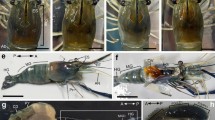Abstract.
CAPA peptides have been isolated from a broad range of insect species as well as an arachnid, and can be grouped into the periviscerokinin and pyrokinin peptide families. In insects, CAPA peptides are the characteristic and most abundant neuropeptides in the abdominal neurohemal system. In many species, CAPA peptides exert potent myotropic effects on different muscles such as the heart. In others, including blood-sucking insects able to transmit serious diseases, CAPA peptides have strong diuretic or anti-diuretic effects and thus are potentially of medical importance. CAPA peptides undergo cell-type-specific sorting and packaging, and are the first insect neuropeptides shown to be differentially processed. In this review, we discuss the current knowledge on the structure, distribution, receptors and physiological actions of the CAPA peptides.
Similar content being viewed by others
Author information
Authors and Affiliations
Corresponding author
Additional information
Received 28 April 2006; received after revision 5 June 2006; accepted 4 July 2006
Rights and permissions
About this article
Cite this article
Predel, R., Wegener, C. Biology of the CAPA peptides in insects. Cell. Mol. Life Sci. 63, 2477–2490 (2006). https://doi.org/10.1007/s00018-006-6187-3
Published:
Issue Date:
DOI: https://doi.org/10.1007/s00018-006-6187-3




